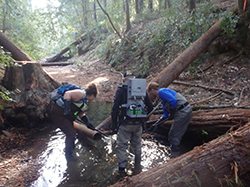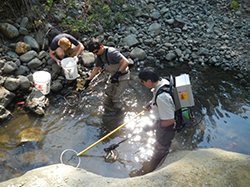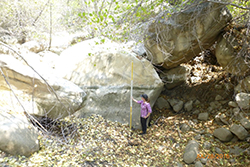
CDFW scientists rescuing juvenile Coho Salmon from isolated and drying pool habitats in Olds Creek, a tributary to the Noyo River in Mendocino County.

CDFW crew relocating steelhead and Coho Salmon to a lower pool on East Weaver Creek in Trinity County in June of 2015.

In July 2016, this usually perennial pool on Matilija Creek in the Ventura River watershed went dry, killing several juvenile steelhead.
One silver lining to emerge from the severe drought that impacted California earlier this decade was that it whetted an appetite to study the event and compile data designed to help fish and aquatic species better weather future droughts.
The state experienced one of the warmest, driest periods in recorded history during this five-year drought (2012 to 2016).
In Jan. 2014, then-Governor Jerry Brown declared the drought a state of emergency. His proclamation directed all state agencies to act to prepare for and mitigate drought-related effects on water supply and aquatic species. The California Department of Fish and Wildlife (CDFW) responded by enacting “drought stressor monitoring” on a statewide level, and recently released a summary report on that effort entitled  Statewide Drought Response: Stressor Monitoring (PDF).
Statewide Drought Response: Stressor Monitoring (PDF).
In late 2016 to early 2017, drought conditions improved considerably in most of the state when winter storms delivered higher than average levels of rainfall. The report describes the results from a collaborative statewide monitoring effort carried out during the period of 2014 to 2017 by scientists from CDFW and other agencies.
The primary purpose was to collect information on the status of populations of fish and other aquatic species, their habitats, and the water quality in the streams in which they reside. The intent was to provide both the scientific community and the public with a better understanding of potential drought-related threats to vulnerable species, and measures taken by CDFW and other agencies to alleviate these threats. This information was also necessary to help CDFW make better-informed management decisions.
The knowledge and data gained in this effort will be used to guide both CDFW and other resource managers during future droughts.
“This was a monumental statewide monitoring effort in response to drought impacts,” said CDFW Environmental Program Manager Jonathan Nelson. “The Drought Stressor Monitoring” developed important baseline documentation of the environmental changes associated with the severe drought conditions, and how the changes affected aquatic habitats and fish populations throughout the state. It was vital to collect this baseline, so we would better understand how to respond both in the present and in the future by creating a boiler plate. This document summarizes the monitoring framework implemented from 2014 to early 2017, how these data informed management actions, and how these efforts will hopefully minimize the impacts on fish and aquatic species during future droughts.”
Overall, CDFW monitored habitat conditions for 17 aquatic species in 141 watersheds, spanning 28 counties. Key findings from the monitor efforts identified several patterns of drought-related ecosystem change throughout the state including 1) increased loss of stream connectivity; 2) degraded water quality, including reduced levels of oxygen and elevated water temperatures; 3) high elevation streams impacted by the formation of winter anchor ice; and 4) elevated instances of fish being stranded by low streamflow and adversely affected by poor water quality.
Drought stressor monitoring was integral to management actions and was particularly critical to the process of aquatic species rescue. Fish rescues were only undertaken after Drought Stressor Monitoring information showed that populations were at high risk of becoming locally extinct in the immediate future. CDFW scientists developed special criteria and guidelines to assess the threat of drought and when to initiate rescue operations. When suitable habitat was available, fish were relocated to nearby habitat within the same stream or watershed to ensure the genetic health of the population and to maintain local adaptations. In cases where habitat was not available, fish were relocated to nearby hatcheries for temporary holding.
Approximately $3 million was dedicated to this effort from then-Governor Brown and more than approximately 100 CDFW staff members contributed to the monitoring and report-summary efforts. CDFW’s Fisheries Branch spearheaded the compiling of the data and finalized the report in collaboration with staff in the department’s various regions.
 View the final report (PDF).
View the final report (PDF).
CDFW Photos.
###
Media Contact:
Kirsten Macintyre, OCEO Communications, (916) 322-8988